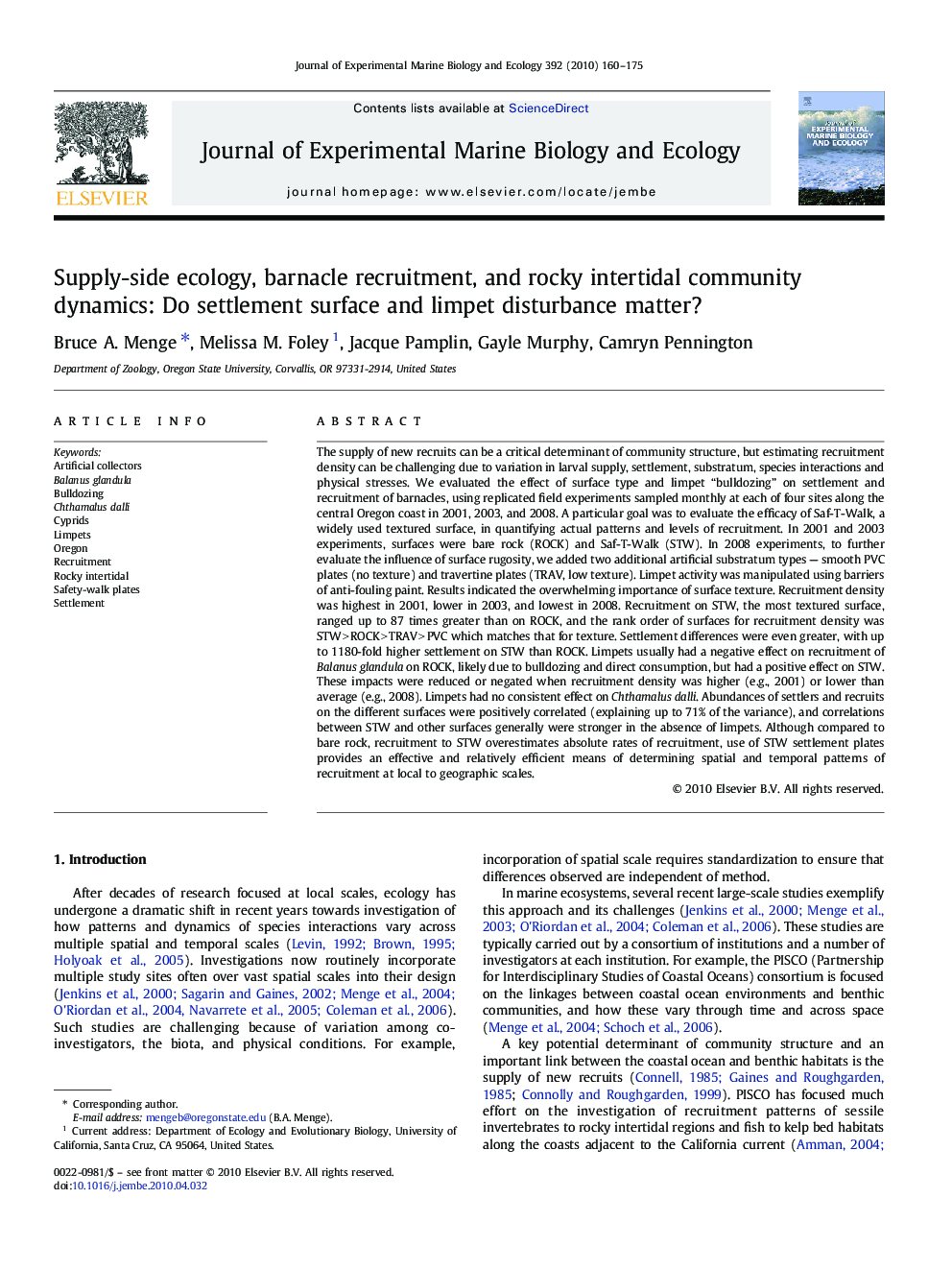| کد مقاله | کد نشریه | سال انتشار | مقاله انگلیسی | نسخه تمام متن |
|---|---|---|---|---|
| 4396562 | 1618468 | 2010 | 16 صفحه PDF | دانلود رایگان |
عنوان انگلیسی مقاله ISI
Supply-side ecology, barnacle recruitment, and rocky intertidal community dynamics: Do settlement surface and limpet disturbance matter?
دانلود مقاله + سفارش ترجمه
دانلود مقاله ISI انگلیسی
رایگان برای ایرانیان
کلمات کلیدی
موضوعات مرتبط
علوم زیستی و بیوفناوری
علوم کشاورزی و بیولوژیک
علوم آبزیان
پیش نمایش صفحه اول مقاله

چکیده انگلیسی
The supply of new recruits can be a critical determinant of community structure, but estimating recruitment density can be challenging due to variation in larval supply, settlement, substratum, species interactions and physical stresses. We evaluated the effect of surface type and limpet “bulldozing” on settlement and recruitment of barnacles, using replicated field experiments sampled monthly at each of four sites along the central Oregon coast in 2001, 2003, and 2008. A particular goal was to evaluate the efficacy of Saf-T-Walk, a widely used textured surface, in quantifying actual patterns and levels of recruitment. In 2001 and 2003 experiments, surfaces were bare rock (ROCK) and Saf-T-Walk (STW). In 2008 experiments, to further evaluate the influence of surface rugosity, we added two additional artificial substratum types - smooth PVC plates (no texture) and travertine plates (TRAV, low texture). Limpet activity was manipulated using barriers of anti-fouling paint. Results indicated the overwhelming importance of surface texture. Recruitment density was highest in 2001, lower in 2003, and lowest in 2008. Recruitment on STW, the most textured surface, ranged up to 87 times greater than on ROCK, and the rank order of surfaces for recruitment density was STWÂ >Â ROCKÂ >Â TRAVÂ >Â PVC which matches that for texture. Settlement differences were even greater, with up to 1180-fold higher settlement on STW than ROCK. Limpets usually had a negative effect on recruitment of Balanus glandula on ROCK, likely due to bulldozing and direct consumption, but had a positive effect on STW. These impacts were reduced or negated when recruitment density was higher (e.g., 2001) or lower than average (e.g., 2008). Limpets had no consistent effect on Chthamalus dalli. Abundances of settlers and recruits on the different surfaces were positively correlated (explaining up to 71% of the variance), and correlations between STW and other surfaces generally were stronger in the absence of limpets. Although compared to bare rock, recruitment to STW overestimates absolute rates of recruitment, use of STW settlement plates provides an effective and relatively efficient means of determining spatial and temporal patterns of recruitment at local to geographic scales.
ناشر
Database: Elsevier - ScienceDirect (ساینس دایرکت)
Journal: Journal of Experimental Marine Biology and Ecology - Volume 392, Issues 1â2, 31 August 2010, Pages 160-175
Journal: Journal of Experimental Marine Biology and Ecology - Volume 392, Issues 1â2, 31 August 2010, Pages 160-175
نویسندگان
Bruce A. Menge, Melissa M. Foley, Jacque Pamplin, Gayle Murphy, Camryn Pennington,